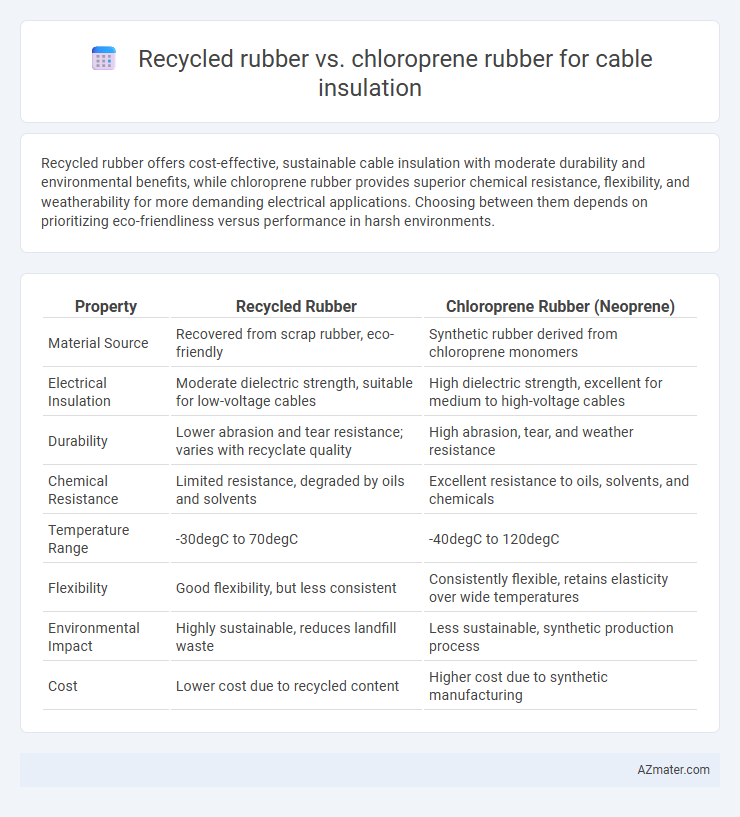Recycled rubber offers cost-effective, sustainable cable insulation with moderate durability and environmental benefits, while chloroprene rubber provides superior chemical resistance, flexibility, and weatherability for more demanding electrical applications. Choosing between them depends on prioritizing eco-friendliness versus performance in harsh environments.
Table of Comparison
| Property | Recycled Rubber | Chloroprene Rubber (Neoprene) |
|---|---|---|
| Material Source | Recovered from scrap rubber, eco-friendly | Synthetic rubber derived from chloroprene monomers |
| Electrical Insulation | Moderate dielectric strength, suitable for low-voltage cables | High dielectric strength, excellent for medium to high-voltage cables |
| Durability | Lower abrasion and tear resistance; varies with recyclate quality | High abrasion, tear, and weather resistance |
| Chemical Resistance | Limited resistance, degraded by oils and solvents | Excellent resistance to oils, solvents, and chemicals |
| Temperature Range | -30degC to 70degC | -40degC to 120degC |
| Flexibility | Good flexibility, but less consistent | Consistently flexible, retains elasticity over wide temperatures |
| Environmental Impact | Highly sustainable, reduces landfill waste | Less sustainable, synthetic production process |
| Cost | Lower cost due to recycled content | Higher cost due to synthetic manufacturing |
Introduction to Cable Insulation Materials
Recycled rubber offers environmentally friendly and cost-effective cable insulation, providing flexibility and good resistance to abrasion and impact. Chloroprene rubber, known for its excellent chemical, oil, and weather resistance, ensures durable and high-performance insulation in harsh conditions. Selecting between recycled rubber and chloroprene rubber depends on specific application requirements such as environmental impact, mechanical stress, and exposure to chemicals or weathering.
Overview of Recycled Rubber
Recycled rubber, derived from processed waste materials like used tires, offers an eco-friendly and cost-effective option for cable insulation with good flexibility and durability. It provides significant environmental benefits by reducing landfill waste and lowering raw material consumption while maintaining adequate thermal and electrical properties for many cable applications. Although recycled rubber may have slightly lower consistency compared to virgin chloroprene rubber, its sustainability advantages make it a viable choice in green manufacturing practices.
Overview of Chloroprene Rubber
Chloroprene rubber, also known as Neoprene, offers excellent resistance to oils, chemicals, and weathering, making it a preferred material for cable insulation in harsh environments. Its superior flexibility, durability, and flame-retardant properties ensure reliable performance in industrial and outdoor applications. Compared to recycled rubber, chloroprene provides enhanced electrical insulation and longer service life, crucial for maintaining cable integrity.
Environmental Impact Comparison
Recycled rubber for cable insulation significantly reduces landfill waste and conserves natural resources by reusing end-of-life rubber materials, lowering carbon emissions compared to virgin products. Chloroprene rubber, while offering excellent chemical and weather resistance, is derived from petroleum-based sources, leading to higher environmental impacts through extraction and production processes. Choosing recycled rubber enhances sustainability by minimizing ecological footprints and promoting circular economy practices in cable manufacturing.
Mechanical Properties: Durability and Flexibility
Recycled rubber offers substantial durability and flexibility for cable insulation, with its ability to endure repeated bending and resist abrasion, making it suitable for applications requiring environmental sustainability. Chloroprene rubber exhibits excellent mechanical properties, including high tensile strength and superior flexibility at low temperatures, which enhances cable longevity in harsh conditions. The choice between recycled and chloroprene rubber depends on the balance between eco-friendly performance and specific mechanical demands like elasticity and wear resistance.
Thermal Resistance and Operating Temperatures
Recycled rubber offers moderate thermal resistance with operating temperatures typically ranging between -20degC to 80degC, making it suitable for low to medium temperature cable insulation. Chloroprene rubber, also known as Neoprene, provides superior thermal resistance, functioning effectively in a broader temperature range from -40degC up to 120degC, which enhances its durability in harsh environments. The higher thermal stability of Chloroprene rubber ensures better performance and longevity for cables exposed to elevated temperatures compared to recycled rubber options.
Electrical Insulation Performance
Recycled rubber offers moderate electrical insulation performance, often sufficient for low-voltage cable applications but with higher variability in dielectric strength due to mixed material sources. Chloroprene rubber (neoprene) provides superior electrical insulation properties, including excellent dielectric strength, resistance to ozone, and consistent performance across a wide temperature range, making it ideal for high-performance cable insulation. The choice between these materials depends on the required insulation standards, environmental conditions, and cost considerations in electrical cable manufacturing.
Cost Analysis: Recycled vs Chloroprene Rubber
Recycled rubber offers a cost-effective alternative to chloroprene rubber in cable insulation due to its lower raw material and processing expenses, reducing overall production costs significantly. Chloroprene rubber, while more expensive, provides superior chemical resistance and durability, justifying its higher price in high-performance applications. Manufacturers often balance cost savings with performance requirements, opting for recycled rubber in budget-sensitive projects and chloroprene rubber where enhanced insulation longevity and reliability are critical.
Safety Considerations and Compliance Standards
Recycled rubber for cable insulation offers an eco-friendly alternative but may present variability in chemical composition that requires thorough testing to meet safety standards such as UL 94 for flammability and IEC 60216 for thermal endurance. Chloroprene rubber, known for its excellent flame resistance, chemical stability, and compliance with rigorous standards like ASTM D2000 and EN 50363, provides reliable insulation performance and enhanced safety in harsh environments. Ensuring compliance with industry-specific regulations and certifications is critical to prevent electrical hazards and maintain long-term insulation integrity.
Application Suitability: Choosing the Right Material
Recycled rubber provides excellent flexibility and environmental benefits, making it suitable for less demanding cable insulation applications where cost-effectiveness is prioritized. Chloroprene rubber offers superior resistance to weathering, oil, and flame, making it ideal for harsh environments and industrial-grade cable insulation. Selecting between recycled rubber and chloroprene depends on the specific application requirements, including durability, exposure conditions, and regulatory standards.

Infographic: Recycled rubber vs Chloroprene rubber for Cable insulation
 azmater.com
azmater.com